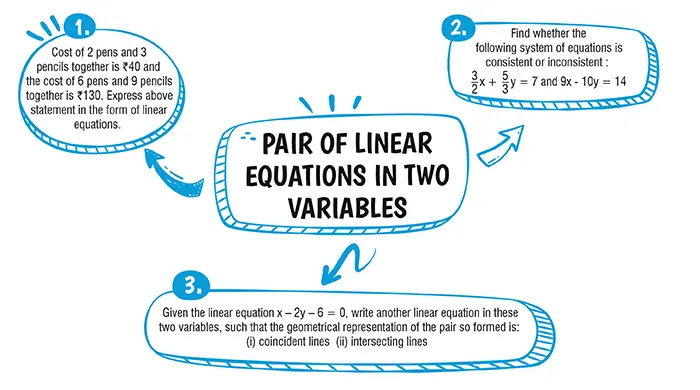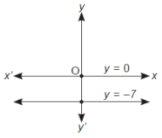Table of Contents

Ans. (a)
Explanation:
\frac{a_1}{a_2} = \frac{b_1}{b_2} = \frac{c_1}{c_2} \\[4 bp]
\frac{2}{a+b} = \frac{3}{a+b–3} \\ [4 bp]
\space\space\space\space\space\space= \frac{7}{4a+b} \\ [4 bp]
\frac{2}{a+b} = \frac{7}{4a+b}\\[4 bp]
8a + 2b = 7a + 7b
a – 5b = 0
Hence lines are coincident.
Ans. (d)
Explanation:
The given pair of equations y = 0 and y = - 7

By graphically both lines are parallel and have no solution.
Explanation:
Let the cost of 1 pen be ₹ x and cost of 1 pencil be ₹ y
Then,
2x + 3y = 40
and 6x + 9y =130
Explanation:
We have,
\space\space\space\space\space\space\space\space\space\space\space\space {\Large\frac{3}{2}}x+{\Large\frac{5}{3}}y - 7 = 0 \\[4.5bp]
and \space\space\space\space 9x - 10y - 14 = 0 \\[4.5bp]
\text{Here,} \space\space\space\space
a_1 = \frac{3}{2}, \space b_1 = \frac{5}{3}, c_1 = -7, \\[4.5bp]
\space\space\space\space\space\space\space\space\space\space\space\space\space\space a_2 = 9, b_2 = - 10, c_2 = - 14 \\[4.5bp]
\text{Thus, } \space\space\space\space\space\space\space\space\space\space\space\space\space\space\space {\Large\frac{a_1}{a_2}}={\Large \frac{3}{2×9}} = {\Large\frac{1}{6}}, {\Large\frac{b_1}{b_2}}={\Large\frac{3}{3(-10)}}=-{\Large\frac{1}{10}}\\[4.5bp]
\text{Since, }\space\space\space\space\space\space\space\space\space\space\space\space\space\space\space {\Large\frac{a_1}{a_2}}\not= {\Large\frac{b_1}{b_2}}
So, given system of equations has unique and it is consistent.
Explanation:
(i) Given, x - 2y - 6 = 0
For lines to be coincident, the condition is:
\space\space\space\space\space\space\space\space\space {\Large\frac{a_1}{a_2}}={\Large\frac{b_1}{b_2}}={\Large\frac{c_1}{c_2}} \\[4.5 bp]Thus, one possible option can be:
\space\space\space\space\space\space\space\space\space 2x - 4y - 12 = 0 \\ [4.5 bp]
\text{Here,} \space\space\space\space\space\space\space\space\space\space a_1 = 1, b_1 = - 2, c_1 = - 6. \\ [4.5 bp]
\space\space\space\space\space\space\space\space\space\space\space\space\space\space\space\space\space\space\space a_2 = 2, b_2 = - 4, c_2 = - 12. \\ [4.5 bp]
{\Large\frac{a_1}{a_2}} = {\Large\frac{1}{2}};{\Large\frac{b_1}{b_2}}= {\Large\frac{-2}{-4}}={\Large\frac{1}{2}}; {\Large\frac{c_1}{c_2}}={\Large\frac{-6}{-12}}={\Large\frac{1}{2}}\\[4.5bp]
∴ \space\space\space\space\space\space\space\space\space {\Large\frac{a_1}{a_2}}={\Large\frac{b_1}{b_2}}={\Large\frac{c_1}{c_2}}\\[4.5 bp]
So, it shows coincident lines.
(ii) Given, 2x - 2y - 6 =0
For intersecting lines
So, they represent intersecting lines.
| Chapter No. | Chapter Name |
|---|---|
| Chapter 1 | Real Numbers |
| Chapter 2 | Polynomials |
| Chapter 3 | Pair of Linear Equations in Two Variable |
| Chapter 4 | Quadratic Equations |
| Chapter 5 | Arithmetic Progressions |
| Chapter 6 | Triangles |
| Chapter 7 | Coordinate Geometry |
| Chapter 8 | Introduction to Trigonometry |
| Chapter 9 | Some Applications of Trigonometry |
| Chapter 10 | Circles |
| Chapter 11 | Areas Related to Circle |
| Chapter 12 | Surface Areas and Volumes |
| Chapter 13 | Statistics |
| Chapter 14 | Probability |
| Chapter Wise Important Questions for CBSE Board Class 10 Maths |
|---|
| Real Numbers |
| Polynomials |
| Pair of Linear Equations in Two Variables |
| Quadratic Equations |
| Arithmetic Progressions |
| Triangles |
| Coordinate Geometry |
| Introduction to Trigonometry |
| Some Applications of Trigonometry |
| Circles |
| Areas Related to Circles |
| Surface Areas and Volumes |
| Statistics |
| Probability |
CBSE Important Questions Class 10
ICSE Important Questions Class 10
CBSE Important Questions Class 10
ICSE Important Questions Class 10